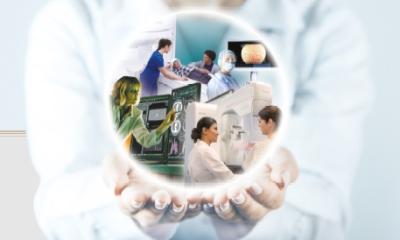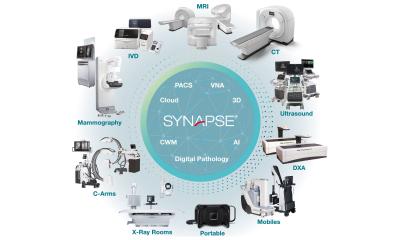ECR
Record breaking attendance at the European Congress of Radiology 2016
The European Congress of Radiology (ECR) 2016 took place March 2 to 6 at the Austria Center Vienna. Over the five days, a new record attendance was achieved: 25,998 onsite and online delegates from 133 countries took part in Europe’s largest medical imaging congress, constituting an increase of 4 percent on last year.

More than 2,100 scientific lectures by almost 700 speakers from 70 countries included presentation of the most recent research results, innovative studies and promising developments, which ultimately all contribute to furthering medical progress for the benefit of patients and reinforcing the role of medical imaging as an essential element in healthcare, particularly in early detection and diagnosis of diseases.
Among the scientific highlights were sessions about hybrid imaging, personalised medicine, data management in radiology, emergency radiology and the role of biomarkers in imaging. Cooperation with colleagues from other disciplines was addressed in a series of multidisciplinary sessions, which featured radiologists, oncologists, gynaecologists and surgeons involved in the interdisciplinary diagnosis and treatment of patients.
Hybrid imaging as a main theme at ECR 2016
Hybrid imaging with PET/CT and PET/MR is becoming increasingly crucial in the routine staging of oncologic disease, treatment planning, early treatment evaluation, and follow up. With ECR 2016 President, Professor Katrine Riklund, being licensed in both radiology and nuclear medicine, it was logical that hybrid imaging would be one of the key aspects of the ECR 2016 programme.
The combination of molecular, biochemical, and structural information that hybrid imaging has to offer is more useful than the information provided by each technique on its own, and can help to optimise the management of cancer patients, particularly those suffering from solid cancers and lymphoma, explained Riklund. She is assistant head of the department of radiation sciences, chief physician of the nuclear medicine department and director of the medical school at Umeå University, and was recently elected president of the newly founded European Society for Hybrid Medical Imaging (ESHI), which was introduced at ECR 2016 in a special joint session. Anybody interested in hybrid imaging can find more information at eshi-society.org.
Focus on personalised medicine
Personalised medicine is about the customisation of healthcare, with decisions and practices being tailored to the individual patient by use of genetic or other information, said Professor Gabriel P. Krestin, Chairman of the Department of Radiology at Erasmus MC, University Medical Center Rotterdam, the Netherlands, at the ECR 2016 press conference.
Precision medicine, or stratification medicine, revolves around the idea that the consideration of individual characteristics – molecular and otherwise – can improve medical research and practice. Precision medicine should, therefore, integrate multiple biomarkers, based on clinical, behavioural, genomic, electrophysiological, and imaging measurements. In this context, medical imaging is intrinsically enabling precision medicine as a wide variety of new imaging techniques and methods produce important biological information about physiology, organ function, biochemistry, metabolism, molecular biology and functional genomics.
‘Big data’ in medical imaging
From assessing customer satisfaction or which healthcare system is the best, to looking at hidden data contained in images, big data analysis can answer many questions related to patient care. Radiologists are in the early stages of using big data for medical imaging and many are still not aware of the potential and consequences it will soon have for their work. Experts from Europe and the United States showed why radiologists should play a role in data generation, sharing, and, most importantly, analysis in a session on the subject at the ECR. The number of radiological examinations worldwide is going up together with the number of images per exam, so big data could help to guide radiologists to the most important things to look for or the key images to look at, according to speakers in that session.
Cooperation with patient representatives
Another successful collaboration at the ECR is represented by the PAG sessions, established by the ESR Patient Advisory Group a few years ago. Together with patient representatives, important subjects were tackled, such as patient-centred care in clinical radiology and data protection and data-sharing for the benefit of patients.
Radiologists spoke about different concepts and implementations of eHealth solutions throughout Europe, and about advantages, opportunities and risks of data-sharing and electronic communication in medical imaging. Another lecture focused on the value of imaging biomarkers for personalised medicine and how to exploit big data in radiology. Patient representatives from Europa Uomo (European Prostate Cancer Coalition) and the Pelvic Pain Support Network addressed key concerns for patients; the question of whether their needs could be reconciled with those of radiologists and researchers, and the willingness of patients to share their data and images to improve the fate of future patients.
‘The Voice of EPOS’: a new feature at the congress
The ECR is well-known for its innovative ideas and, in keeping with this reputation, the new feature ‘The Voice of EPOS’ was introduced this year. The authors of the best posters submitted for ECR 2016 were invited to present their work in person on a stage in the ‘EPOS Arena’. Even at its premiere the new initiative proved to be a huge success; in 350 lectures the best posters were presented, grouped into organ-based and language-based sessions, to serve a multilingual and international audience. The numerous spectators and the lively discussions leave only one logical conclusion: ‘The Voice of EPOS’ will be an integral constituent of ECR 2017.
ECR 2016: impressive figures
Here are a few further figures we are proud to present: 11,796 professional delegates (up 4%), 8,275 industry representatives (up 1%), 10,346 ECR Live Viewers, 35,540 returnable bottles of water, 5 tons of apples, 12,000 tote bags, more than 3,000 personalised CMEasy tags, 7,100 ECR 2016 App users, over 5 Terabytes of network traffic via the ECR WiFi, and 8,000 concurrent WiFi users.
The next European Congress of Radiology (ECR 2017) will take place March 1 to 5, 2017, again in Vienna, under the aegis of Professor Paul M. Parizel from Antwerp, Belgium.
16.03.2016











